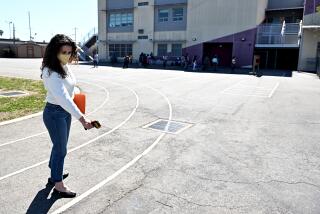Expansion Plans Set, and Now the Funds Start
For the past five years, Cal Lutheran University officials have struggled to design an upgraded campus that will accommodate a larger student body, embrace the latest technology and keep its neighbors happy.
The years of careful planning, design and revision paid off several weeks ago when the Thousand Oaks City Council unanimously approved a plan that will double the size of the campus and add 20 buildings.
Now comes the hard part: raising the $75 million needed to make the ambitious plan a reality.
A campaign to raise the money is already in motion. For the next two years, the university will be quietly wining and dining its most prestigious donors.
George E. Engdahl, vice president for university advancement, is heading up the campaign. He says the key is showing potential donors how their money will make a lasting difference to the university.
“What we do in fund-raising is we build relationships. You don’t walk in the front door and ask for $100,” Engdahl said. “You build relationships.
“There are a lot of people out there who love to get involved with something that has the opportunity to move forward,” he said.
Campus officials think that once people grasp the dramatic nature of CLU’s vision for itself, they will be eager to help. The plan calls for:
* Five to six academic buildings, one administration structure and a student union to support an expanded student population.
* Eight residence halls to accommodate the 1,500 students, up from the more than 900 at present, who officials expect will live on campus in the coming years.
* Expansion of athletic facilities to meet the needs of the 80% of students who participate in sports programs. The first project will be a gymnasium located north of Olsen Road, followed by an expanded sports complex. That will include tennis courts, soccer fields, a football stadium and an aquatic center, all of which will be just north of Olsen Road.
* A new performing arts center, which will house a 500- to 700-seat black-box theater, visual arts studios and recital halls.
The first projects to come on line include a School of Education building, which is due to be completed next year. And by 2001, a gymnasium is expected to be erected.
The rest of the sports complex will be built next, followed by the arts center. Construction of the new student housing will come after that.
Administrators say that despite such expansion, they are committed to preserving the attractive fields on the north portion of the campus.
“We’re only using about one-third, less than half, of the total acreage available,” said Dennis Gillette, who is vice president for administrative services/treasurer and also a city councilman. “That enables us to keep the open green natural areas, without creating the congested feeling that you see on a number of other campuses.”
Officials are hopeful that the new facilities will attract a high-caliber student body and faculty.
“The new buildings, the new facilities, the new offerings will appeal to students and will continue our healthy enrollment ascent that we’ve been experiencing for the past few years,” said Carol Keochekian, senior director of university relations.
Despite the long road ahead, university officials are confident. They have already garnered the support of most neighbors and city officials. In a city where the word “growth” is often met with resistance, that’s no small feat.
Although city officials had the deciding vote on the project, members of the community had been invited to offer opinions to Cal Lutheran administrators for more than a year. Regular meetings were held with local homeowner associations and community groups to explain planned changes. Neighbors were also invited to offer feedback on the plan.
A few weeks before the City Council was due to make its final decision, several dozen residents on Cedar Heights Drive, near the southwest corner of the campus, came forward.
The residents said they had been forgotten in the feedback process, and were upset about the proposed addition of residence halls near their homes. They worried about more noise and light pollution from the campus.
The council delayed its decision so the university could resolve the complaint. In the meantime, school officials decided to move the dormitories farther away from the homes on Cedar Heights Drive.
City officials are eager to see the university expand because they believe a bustling university will help the city prosper. The campus already reaches out to the surrounding area by hosting community events, including seminars on business leadership and baseball camps for youngsters.
More to Read
Sign up for Essential California
The most important California stories and recommendations in your inbox every morning.
You may occasionally receive promotional content from the Los Angeles Times.










